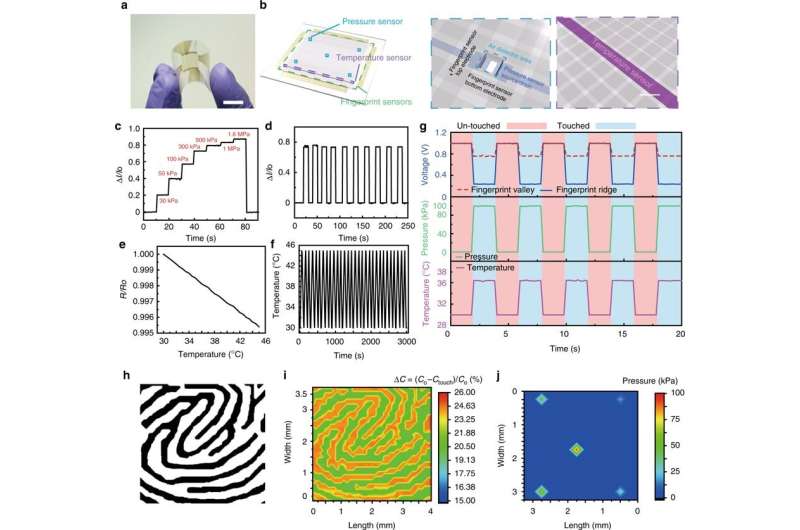July 6, 2018 weblog
South Korea team may inspire fingerprints as fave phone opener

Smart fingerprint sensor arrays for the smartphone have become a focal point of new research. Fingerprint sensors are getting a rethink, and the strategy being proposed is now reported in Nature Communications. The report is looking at sensor arrays that, at the same time, can pick up tactile pressure and finger skin temperature.
Essentially, "They decided to turn an entire display into one giant sensor, using a newly developed transparent electrode," said MailOnline.
What does that mean to you? It means that you could pick up your smartphone and forget about having to cope with an activation button. Instead, you could place your finger anywhere on the display for identification purposes.
The authors wrote, "Currently, capacitive fingerprint sensors that are used in mobile devices, especially in smartphones, are still opaque, and implemented either within an activation button or in areas on the back of these devices." But, can we rethink how they can be part of the phone in the future? "In order to enhance the usability of mobile devices," they wrote, "a display that occupies a relatively larger area of the total device size has the highest priority in terms of product design."
Jang-Ung Park and colleagues are behind a new approach for fabricating sensor arrays that are flexible, transparent and multifunctional. Their transparent electrodes are based on a random hybrid network nanostructure. It consists of long silver nanofibers and fine silver nanowires.
Speaking to MailOnline, Dr. Jang-Ung Park said: 'As people begin to seek borderless phones with a maximised screen size, they can't find a spot for the fingerprint sensor that usually sits within the home button of a phone. We developed 'transparent' fingerprint sensors, aiming to detect a fingerprint placed anywhere on the display of a phone."
The way Chris Smith sees it in Trusted Reviews: "Such a solution could prevent artificial fingerprints being used to prize open smartphones, checking that the subject is human."
Three characteristics are noteworthy in this network: (1) high optical transmission, (2) low electrical resistance and (3) it being substantially resistant to mechanical bending. What the phone owner gets: A fingerprint sensor array that can accurately detect the ridge and valley regions of a fingerprint during touch.
The authenticity advantage cannot be ignored. As Smith wrote in Trusted Reviews, "the scientists from the Samsung Display-UNIST Center in South Korea say the new tech even meets FBI security standards."
Another potential use case is for the arrays to help smartphone users check their temperatures. Smith said "a fingerprint sensor could take your temp when you're feeling under the weather and report the reading back to a phone app."
"Transparent and flexible fingerprint sensor array with multiplexed detection of tactile pressure and skin temperature" is the title of their paper; the authors are with the Samsung Display-UNIST Center.
The question on many minds is when we might expect this research to grow into product planning. Will the sensors replace finger-print activation buttons in the future? How likely is that?
John McCann at TechRadar said, "don't expect this technology to hit phones in the next year or so." McCann said, "While the technology may be working in the labs, it'll likely be several years before it could feasibly find its way into our smartphones."
More information: Byeong Wan An et al. Transparent and flexible fingerprint sensor array with multiplexed detection of tactile pressure and skin temperature, Nature Communications (2018). DOI: 10.1038/s41467-018-04906-1
Abstract
We developed a transparent and flexible, capacitive fingerprint sensor array with multiplexed, simultaneous detection of tactile pressure and finger skin temperature for mobile smart devices. In our approach, networks of hybrid nanostructures using ultra-long metal nanofibers and finer nanowires were formed as transparent, flexible electrodes of a multifunctional sensor array. These sensors exhibited excellent optoelectronic properties and outstanding reliability against mechanical bending. This fingerprint sensor array has a high resolution with good transparency. This sensor offers a capacitance variation ~17 times better than the variation for the same sensor pattern using conventional ITO electrodes. This sensor with the hybrid electrode also operates at high frequencies with negligible degradation in its performance against various noise signals from mobile devices. Furthermore, this fingerprint sensor array can be integrated with all transparent forms of tactile pressure sensors and skin temperature sensors, to enable the detection of a finger pressing on the display.
© 2018 Tech Xplore




















